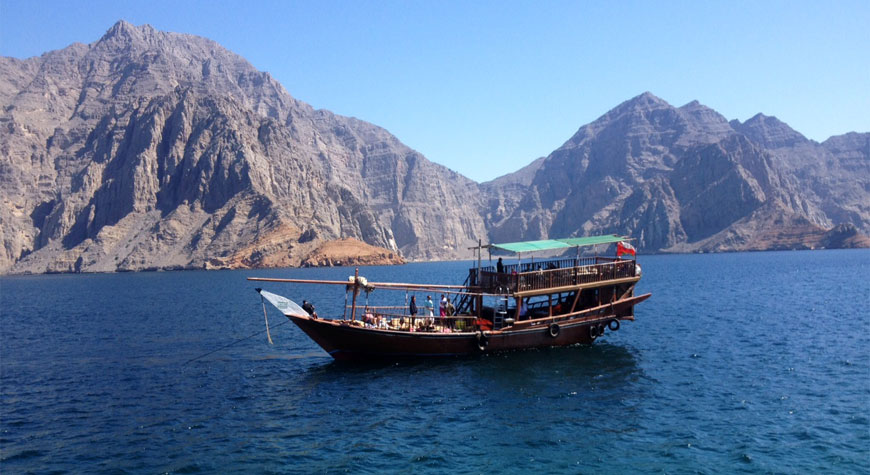Every inch of the fjord in Oman is dripping with uplifting clichés. Its visual depiction would make the Hallmark Channel look more like a documentary network on tax inventory.
The Gulf state of Oman hardly springs to mind when one envisions paradise. But aboard a wooden boat, sailing along the turquoise waters of the fjord, past white sandy beaches at the foot of dessert and rocky mountains – and throw in dolphin singing for good measure too – you’ll be surprised with what you’ll find.
The Islamic Sultanate may not be high on holidaymakers’ list, but if you’re into scenic beauty and history, it is a perfect destination. Thanks to its preserved cultural heritage, many of the centuries-old fortress and castles are still standing for visitors amid sweeping scenery.
Our dhow (boat) cruised through Oman’s fjord at the Musandam peninsula, half an hour by boat from Iran. When it reached Telegraph Island, it occurred to me that this touristy cruise was a crash course in colonial history.
Telegraph island is where the Brits first laid telegraph cable that stretched to Basra, Iraq in 1864, hence the namesake. You can see remnants of the desolate post where the officers used to work. Not a bad office space, I thought, except in the summer the temperatures soar to a ‘boiling’ 45 degrees Celsius.
Through the incredibly clear water, I saw a cluster of coral rocks and little fish swimming in zigzag. Strapping my snorkeling mask, I plunged into the cool water. A few scattered white corals, the view below might not be the Garden of Eden but the towering mountains makes you feel small like tiny fish in the ocean.
The snorkeling was a cool respite following a thrilling start. After leaving Khasab harbor, the dhow braced through choppy waters and I felt like I was inside a bouncing ball that’s been thrown to the sea. The dhow then slowed down as it entered the 17 km-long fjord, allowing me to be immersed in the view in peace.
Our captain, a 40-year Old Iranian fisherman named Abdullah, navigated the dhow through the fjord with ease. He told me he’d been doing it for 13 years, and at night he still had to go out fishing to supplement his income.
“So, you still keep your daytime job at night, huh?” I remarked jokingly with a self-triumphant smirk. No response. Typical me.
As the sun reaches its zenith, the mountains’ rugged details became darkened and we sailed past a quiet fishing village whose stone houses seemed to have blended into the cliffs. En route we also saw a couple of mountain goats staring back at us.
Joining me on the boat were a Brit couple with toned down Geordie accent (from north east England) and an American couple who just moved in to Dubai. I was made welcome throughout the six-hour voyage, and the enjoyable conversation was a real bonus for solo traveller like me.
The American traveller Bryan was an aeronautical engineer working for a company that supplies engines to Airbus. Since I’m an airline geek, our conversation took off to a “flying start” and we talked about all the Boeings and Airbuses under the star. You can stop rolling your eyes now.
The land of forts and castles
Moving to dry land, I experienced Oman’s other gems, its forts and castles. Near Khasab harbor, a 17th century coastal fort by the same name sits against the backdrop of a dramatic cliff. The Portuguese built it to exert their dominance but the Omani forces remodeled the fort after expelling the Portuguese.

Central to this sand-colored fort is a circular tower that houses exhibits in a style that is uninspiringly old school (animal fossils and other items behind glass cages). The castle has several rooms celebrating the life of local traditions with wax figures decked out in traditional outfit.
Personally, I found the rooms a bit creepy because the lifelike wax figures did look alive. It’s like stepping inside the set of horror flick “House of Dolls’ with Paris Hilton – dressed in all-enveloping Hijab – participating in an arranged marriage.
Then there’s Jabreen castle, which lies about 175 km from the capital city Muscat. When travelling, ignorance is bliss, because it keeps you in suspense as to what lies ahead. Before venturing inside the castle, my 65-year-old driver Fareed told me to look up to the ceilings inside the rooms. I was intrigued.
Most the castle rooms are adorned with painted ceilings on wood panels, and the best ones are inside the “Hall of the Sun and the Moon” .You can tell by its poetic name, the room must be the jewel of the castle. Stepping inside the high-ceiling chamber, I saw a pair of two pointed arched windows perched underneath the ceiling. The windows are decked out in decorated wooden bars and they are designed to let the moon light streams at night.
The painted ceilings were on carved wooden beans with floral motifs and intricate patterns. The long rectangular room has carpets and pillows. Grab a pillow and lay down to enjoy the view above! It’s as if you looked at a series of floating Persian carpets.
The history behind Jabreen castle reads a bit like Game of Thrones meets The Horse Whisperer. Sibling rivalry, bloodshed, and family betrayal all rolled into one with one special horse. A horse you asked? Yes, among the castle’s impressive arrays of rooms is a chamber reserved for one of the ruler’s horse.
The tiny windowless “horse room” is nearly hidden at the end of a narrow and curved stairway. According to the brochure, it was built to “facilitate a quick escape and for reasons of sentiments”. Right, someone had an unhealthy relationship with his pet.
The last ruler of the castle was the great-great-great grandfather of Oman’s current ruler, Sultan Qaboos bin Said al Said. Highly revered, his name is omnipresent in the country, from the main airport, mosque, university, roads and hospital. The 74-year-old leader has been credited for modernizing the country with massive infrastructure development.
Charmed by old Muscat and the Souqs
If you only have a few days to venture, don’t fret about missing out on the outback experience because Muscat is a city worth exploring. Scattered with colorful mosques and souqs or bazaars, there’s a lot to offer in this harbor city, particularly if you’re into culture and Islamic architecture.
Omanis are generally quite approachable and they are very proud of their culture, which makes Muscat city quite charming. A typical winter afternoon in old Muscat would see Omani men clad in crisp white dishdasha robes and embroidered Kuma caps mingling on the streets. I hardly saw any locals dressed in western outfit, even in the central business district.
The Grand Mosque of Oman by the name of – you guessed it – Sultan Qaboos is particularly impressive to visit at night. You can see the lit mosaic wall paintings on the hallway and the orange glow of the mosque dome. With so much intricate designs on the wall and the ceiling, the mosque oozes festive and holy atmosphere at the same time. Non-Muslims can visit the prayer hall except during praying time.
Unlike in Dubai and Doha, the centuries old souqs remain the true nucleus of the communities, as opposed to some modern-day reinventions built for the tourists. Everybody’s favorite is the old Mutrah souq, which sits under the gaze of Mutrah fort. Omanis come here to shop household goods and make colorful dresses hidden under the black Abaya (see the 7 top tips sidebar) Thronged with souvenir shops, the seaside souq may seem touristy. But it still offers authentic shopping experience while mingling with the Omanis, plus you can visit the Old Muscat’s cornice, which commands a great view of the city at night.
My most candy-melting moment, however, was back in Oman’s Fjord. As we approached the last turn, Abdullah our captain made a whistling noise and upped the cruise speed. Dolphins must be the most attention-seeking creatures on planet. In an instant, a group of three dolphins swam and jumped out of the water by the side of our boat, creating an illusion of ferry wheels on full speed.
Sensing our excitement, the dolphins teased us by going back and fort to the left and right of our boat. One second they disappeared below the boat and the next second reappeared on the other side. We followed the dolphins’ cheeky game skidding to the left and right like a compass needle going awry.
I giggled incessantly like a schoolboy (yes, some schoolboys do giggle). The only thing missing was a dramatic score that builds up to a climatic high note, capping off that picture-perfect Hallmark moment.
Tomi Soetjipto is a former journalist at Thomson Reuters, Al Jazeera English and BBC Indonesia. He now works for an international development organization in Jakarta. Follow @TomiSoetjipto on Twitter.
*All photos courtesy of Tomi Soetjipto








Comments